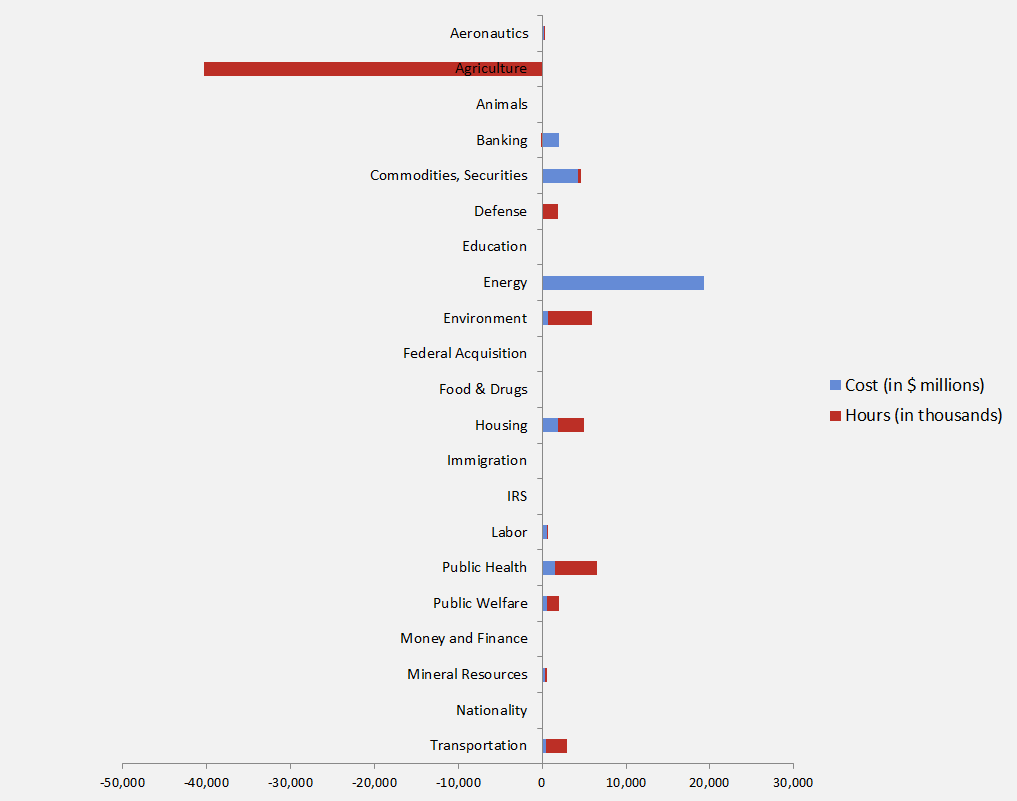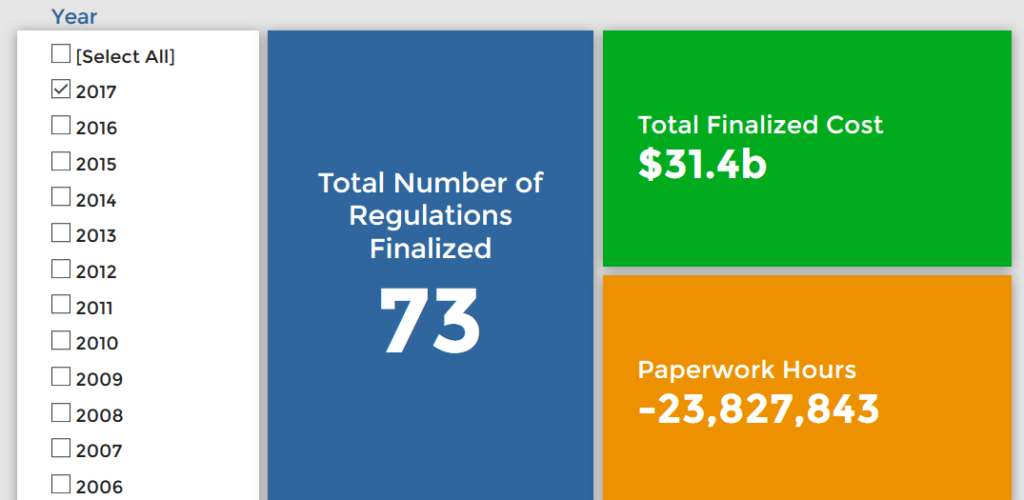Week in Regulation
May 8, 2017
Regulatory Offsets Needed
With a formal proposal to implement updated standards for skilled nursing facilities, the administration will now have to devise at least two other rules to offset the costs of the new proposed rule. By contrast, the administration also proposed two other health care rules, but determined that the costs were de minimis, and thus not applicable under the one-in, two-out executive order. For the week, regulators published $96 million in costs; there were $19 million in disbenefits and more than one million in paperwork burden hours. The per capita regulatory burden for 2017 is $442.
Regulatory Toplines
- New Proposed Rules: 31
- New Final Rules: 48
- 2017 Total Pages of Regulation: 21,302
- 2017 Final Rules: $31.39 Billion
- 2017 Proposed Rules: $111.7 Billion
The American Action Forum (AAF) has catalogued regulations according to their codification in the Code of Federal Regulations (CFR). The CFR is organized into 50 titles, with each title corresponding to an industry or part of government. This snapshot of final rules (a change from earlier versions) will help to determine which sectors of the economy receive the highest number of regulatory actions.
The first rule that requires a regulatory offset under the one-in, two-out order implements revised standards for skilled nursing facilities. Annual costs are $60 million, with nearly 800,000 paperwork burden hours. According to the proposal, “the implications of the rule’s costs and cost savings will be further considered in the context of our compliance with Executive Order 13771.”
By contrast, there were two other proposals that could add $7.7 million and $3.4 million in annual burdens, respectively. The regulatory impact analyses noted the proposals impose just de minimis costs. The combined paperwork burden of the measures is notable: 225,000 hours.
Tracking Regulatory Modernization
The regulatory disbenefits this week are courtesy of the formal delay of the menu labeling rule for restaurants. The rule forecasts $8 million in fewer immediate compliance costs, but also $19 million in foregone benefits, or disbenefits. The new compliance date is May 7, 2018.
With the passage of another CRA measure in the Senate this week, the House and Senate have both passed 14 CRA resolutions, with the Senate passing 14 total and the House 15 in all. President Trump has signed 13 and Congress and the administration have eliminated $3.7 billion in total regulatory costs and 4.2 million paperwork burden hours. There is just one additional House CRA approvals on which the Senate has not voted: a notable methane flaring measure ($1.8 billion in costs). To date, there have been more than 30 resolutions of disapproval introduced.
On regulatory budget implementation, below are the agencies that have accrued annual savings and are technically compliant with the president’s one-in, two-out budget:
- Defense: $400 million
- Interior: $360 million
- Education: $100 million
- Labor: $78 million
- HHS: $0.02 million
All non-DOL figures are the result of CRA resolutions of disapproval. Given their historic regulatory output, AAF can predict that Defense, Interior, and Education will likely meet the goal of $0 in net regulatory costs by the end of this fiscal year. However, if the $60 million rule that was proposed this week becomes final, HHS will need to find at least two regulations to offset the cost.
Affordable Care Act
Since passage, based on total lifetime costs of the regulations, the Affordable Care Act has imposed costs of $53 billion in final state and private-sector burdens and 176.9 million annual paperwork hours.
Dodd-Frank
Click here to view the total estimated revised costs from Dodd-Frank; since passage, the legislation has produced more than 74.8 million final paperwork burden hours and imposed $38.5 billion in direct compliance costs.
Total Burdens
Since January 1, the federal government has published $143.1 billion in compliance costs ($31.39 billion in final rules) and has cut 18.8 million paperwork burden hours (due to 23.8 million in reductions from final rules). Click below for the latest Reg Rodeo findings.












